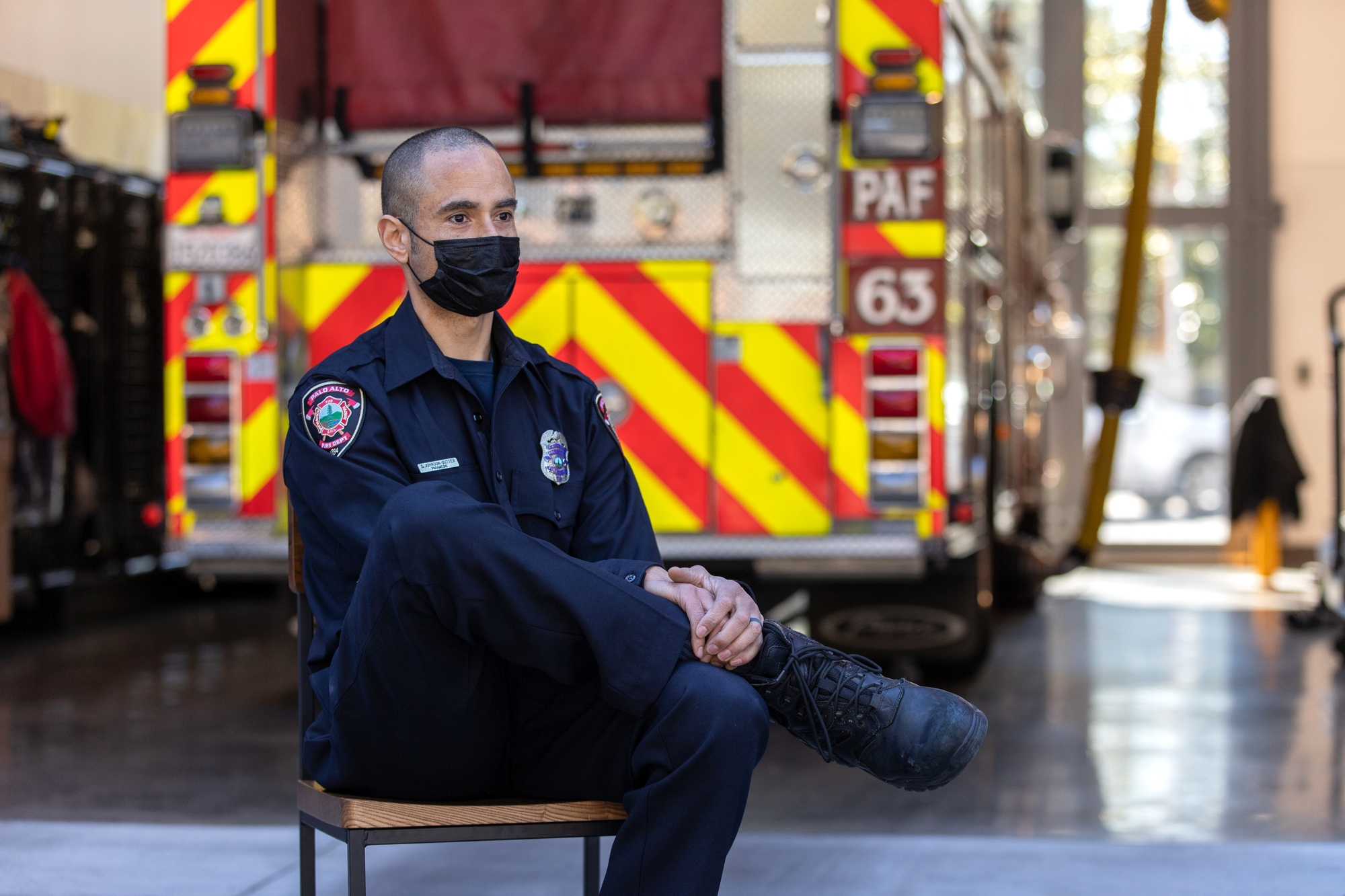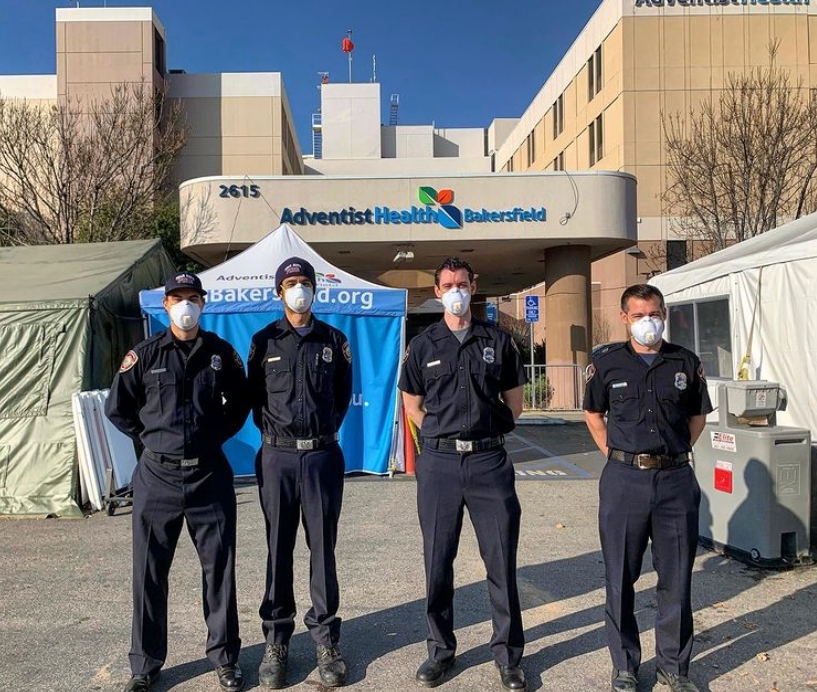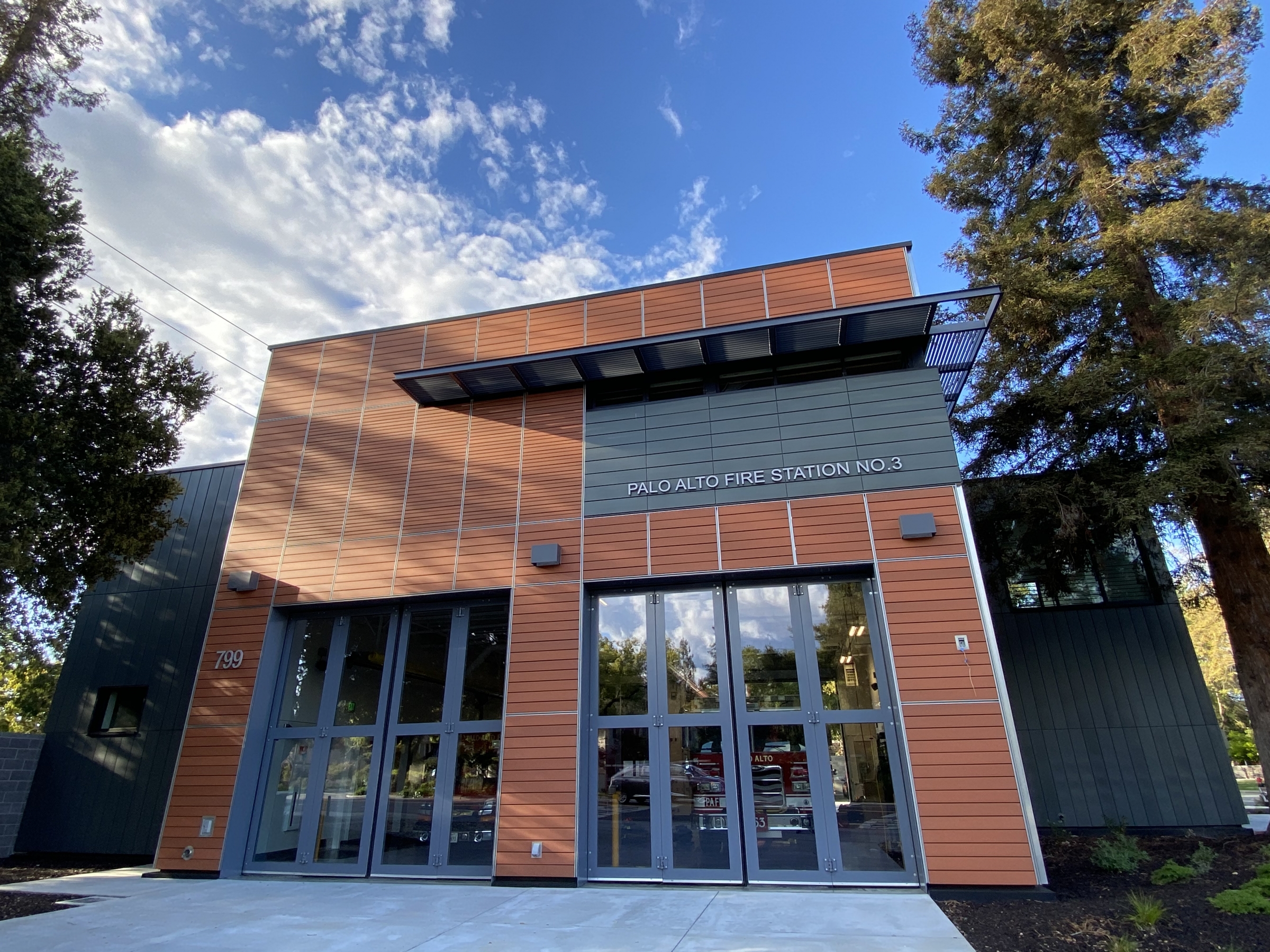As a paramedic in the Palo Alto Fire Department, Sunny Johnson-Gutter is no stranger to helping residents deal with trauma, devastation and — at times — even celebration.
In his 10 years in Palo Alto, he has responded to emergencies both within the city limits — as when he helped deliver a baby on University Avenue in 2011 — and beyond, as when he took part in a 2019 strike force that battled wildfires in Napa County.
But last month, Johnson-Gutter and Palo Alto firefighter/paramedics Gregory Coffelt, Jordan Braa and Matt Ferguson found themselves in a new setting: a hospital in Bakersfield that was overflowing with COVID-19 patients after a surge of cases in the weeks that followed the holiday season.
When the firefighters arrived at Kern Adventist Hospital on Jan. 3, the intensive care unit was overflowing, Johnson-Gutter said in a recent interview. The hospital had established care treatment areas by putting up tents in the parking lot, and nurses and doctors were hustling to take care of "waves upon waves" of patients.
The Palo Alto paramedics immediately joined the fray by helping to administer medication, take vital signs and move patients, some of whom were intubated and had to be flipped over several times per day. In many cases, the assistance came down to helping a patient get to the bathroom or providing them with a cup of water, he said. With nurses focused on providing vital care to dozens of patients at a time, the "human aspects" of patient care sometimes got relegated to a second tier of importance, he said.
"It's just a constant barrage of needs, needs, needs and needs — people who are sick, and they need care and compassion," Johnson-Gutter, 43, said. "Everyone is doing a great job, but I just don't know how they can continue to do that without having some sort of relief."
The human aspect has always been a critical component of the job for Palo Alto firefighters, and it's one that has been put to the test in this year of social distancing. Firefighters and paramedics are, after all, the ultimate team players. They respond in units, and when they're not on calls, they train, decompress and — to a great extent — reside in neighborhood stations, where they work 48-hour shifts.
So when the COVID-19 pandemic began to accelerate in February and March of 2020, they weren't just dealing with the threat of a mysterious and deadly virus; they were also confronting new rules that, in many ways, ran counter to the firefighter ethos of togetherness.
In the early weeks of the pandemic, Palo Alto firefighters were told that they can no longer eat meals together. Dining in separate rooms, Johnson-Gutter said, took away from the normal bonding experience, which he said is a critical way that department staff recuperate, share experiences and re-energize after calls.
So employees responded by installing heat lamps and creating outdoor areas that allowed them to share their meals while maintaining a safe distance. They also agreed that they would do everything they could to protect one another from the spreading virus.
"We all made an agreement that we would wear masks even before a lot of other departments were making a push," he said. "We encouraged each other, 'I'm wearing my mask to show support for the fact that I don't want you and your family to get sick.'"
Even with these precautions, the first responders felt heightened anxiety, thanks in no small part to a shortage of personal protective equipment. Much like hospital workers and emergency responders elsewhere, Palo Alto firefighters were asked to reuse gowns and N95 masks. There was also a lack of knowledge back then about the incubation period of the virus and the best ways to stem its spread.
Despite these uncertainties, Johnson-Gutter said he and his colleagues at the Fire Department were confident that they'd be able to cope with the looming threat. They were resigned to the fact that some would probably catch the virus, but they also felt that, if that were to happen, they'd have the means to take care of themselves and the city's support.
While maintaining social distance between themselves, Johnson-Gutter's team at the Rinconada Park fire station, known as Station 3, was also confronting isolation from the wider community. When the newly rebuilt station opened in March 2020 and the Station 3 crew was able to return to its assigned neighborhood after a two-year exile in a makeshift station near the Baylands, the long-awaited milestone passed without any public ceremony or a community celebration.
Firefighter crews also had to halt their tradition of shopping at local supermarkets. Not wishing to go into the crowds and compete for space with other shoppers, including local seniors, Station 3 staff began to buy supplies in bulk from food distributors, Johnson-Gutter said.
That was just one of many adjustments that emergency responders have had to make over the past year, as they were basically charged with crafting a new playbook to deal with a once-a-century threat. Among other protocols paramedics established: They limited the number of staff members who got close to patients with COVID-19 symptoms. They also began to rely more on decontamination misters after calls that involve potential COVID-19 cases.
Despite these changes, and the ongoing concerns about recent (and pending) budget cuts in the Fire Department, Johnson-Gutter said he and his colleagues feel fortunate to have the ability to do a job they love and to see their close friends and colleagues on a daily basis — a luxury that many people don't have these days.
He was also happy to volunteer for the assignment in Bakersfield, where the response unit stayed for two weeks. Even though the four paramedics had different shifts, they made a point to still meet daily for outdoor meals.
"It is so integral in just how we've been trained and how we've learned to deal with stress," Johnson-Gutter said. "Being away from our families for two weeks straight, it was very refreshing to be able to meet with our co-workers on a daily basis and kind of recount what we learned and pass on information and kind of share experiences."
When they returned, each member of the team went through five days of quarantine and a debriefing session with a department therapist. They took some time to reflect on the stress of the prior two weeks. The trip, he said, left them feeling "on edge."
"It took us a while to kind of process, 'Why am I having this argument with my wife right now? What is this about?' It's this realization that you've just been through a very stressful experience, and it's going to take a while to readjust to normal life. It's normal. It's OK to be aware of it."
The trip also brought into stark relief the ways in which different regions have responded to the pandemic. Here, tech workers immediately shifted to remote working, which helped halt the spread of COVID-19, and public health officials quickly imposed shelter-in-place rules. In Bakersfield, many employees don't have the luxury of working remotely, and the health restrictions had been less stringent — as evidenced by restaurants that were completely packed with indoor customers, he said.
While the city's budget challenges continue to cast a shadow over the Fire Department, the past few months have brought some hope. Every member of the department has been vaccinated against COVID-19, and the city was largely spared during the post-holiday surge, when other parts of the county saw increases in cases.
"You walk around Palo Alto and you see people running with masks on," Johnson-Gutter said. "People in this community and surrounding communities are very much onboard with following the guidelines, which has made our jobs much more bearable for sure."





Comments